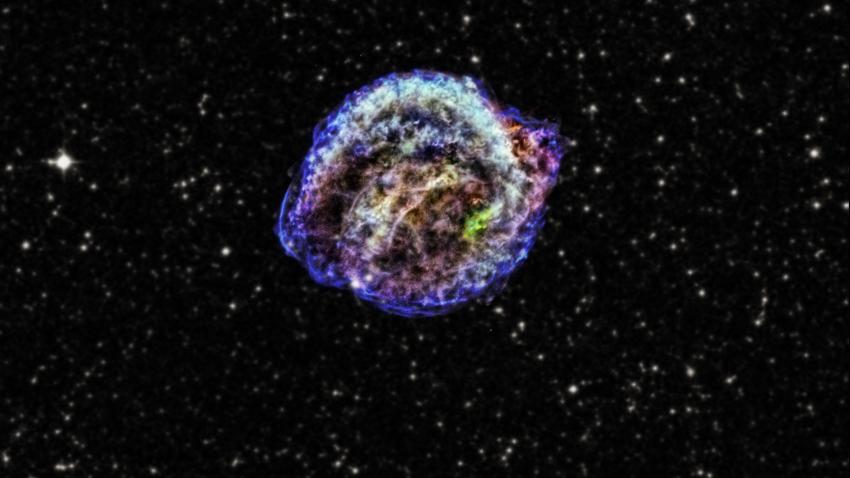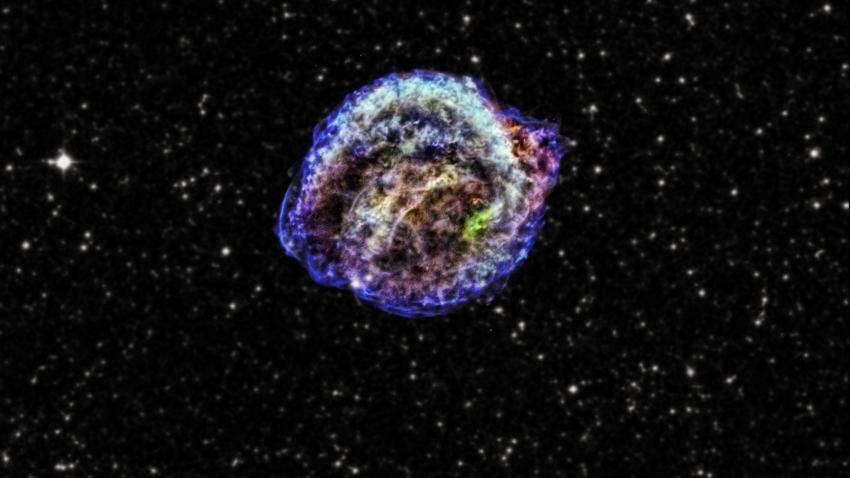The final stage of cataclysmic explosions of dying massive stars, called supernovae, could pack an up to six times bigger punch on the surrounding interstellar gas with the help of cosmic rays, according to a new study led by researchers at the University of Oxford. The work will be presented by PhD student Francisco Rodríguez Montero today (19 July) at the virtual National Astronomy Meeting (NAM 2021).
When supernovae explode, they emit light and billions of particles into space. While the light can freely reach us, particles become trapped in spiral loops by magnetic shockwaves generated during the explosions. Crossing back and forth through shock fronts, these particles are accelerated almost to the speed of light and, on escaping the supernovae, are thought to be the source of the mysterious form of radiation known as cosmic rays.
Due to their immense speed, cosmic rays experience strong relativistic effects, effectively losing less energy than regular matter and allowing them to travel great distances through a galaxy. Along the way, they affect the energy and structure of interstellar gas in their path and may play a crucial role in shutting down the formation of new stars in dense pockets of gas. However, to date, the influence of cosmic rays in galaxy evolution has not been well understood.
In the first high-resolution numerical study of its kind, the team ran simulations of the evolution of the shockwaves emanating from supernovae explosions over several million years. They found that cosmic rays can play a critical role in the final stages of a supernova’s evolution and its ability to inject energy into the galactic gas that surrounds it.
Rodríguez Montero explains: “Initially, the addition of cosmic rays does not appear to change how the explosion evolves. Nevertheless, when the supernova reaches the stage in which it cannot gain more momentum from the conversion of the supernova’s thermal energy to kinetic energy, we found that cosmic rays can give an extra push to the gas, allowing for the final momentum imparted to be up to 4-6 times higher than previously predicted.”
The results suggest that gas outflows driven from the interstellar medium into the surrounding tenuous gas, or circumgalactic medium, will be dramatically more massive than previously estimated.
Contrary to state-of-the-art theoretical arguments, the simulations also suggest that the extra push provided by cosmic rays is more significant when massive stars explode in low-density environments. This could facilitate the creation of super-bubbles powered by successive generations of supernovae, sweeping gas from the interstellar medium and venting it out of galactic disks.
Rodríguez Montero adds: “Our results are a first look at the extraordinary new insights that cosmic rays will provide to our understanding of the complex nature of galaxy formation.
Media contacts
Anita Heward
Royal Astronomical Society
Mob: +44 (0)7756 034 243
nam-press@ras.ac.uk
Dr Morgan Hollis
Royal Astronomical Society
Mob: +44 (0)7802 877 700
nam-press@ras.ac.uk
Dr Robert Massey
Royal Astronomical Society
Mob: +44 (0)7802 877 699
nam-press@ras.ac.uk
Vittoria D'Alessio
PR and Media Manager
University of Bath
Tel: +44 (0)1225 383 135
vda26@bath.ac.uk
Science contacts
Francisco Rodríguez Montero
University of Oxford
francisco.rodriguezmontero@physics.ox.ac.uk
Images and captions
Notes for editors
About the National Astronomy Meeting
The Royal Astronomical Society National Astronomy Meeting (NAM 2021) will take place online from 19 - 23 July 2021. Bringing together around 800 astronomers and space scientists, the conference is the largest annual professional astronomy and space science event in the UK, and sees leading researchers from around the world presenting their latest work.
NAM 2021 incorporates the annual meetings of the Magnetosphere Ionosphere Solar-Terrestrial (MIST) and UK Solar Physics (UKSP) groups. The conference is principally sponsored by the Royal Astronomical Society (RAS), the Science and Technology Facilities Council (STFC) and the University of Bath.
Follow NAM 2021 on Twitter
About the Royal Astronomical Society
The Royal Astronomical Society (RAS), founded in 1820, encourages and promotes the study of astronomy, solar-system science, geophysics and closely related branches of science. The RAS organises scientific meetings, publishes international research and review journals, recognises outstanding achievements by the award of medals and prizes, maintains an extensive library, supports education through grants and outreach activities and represents UK astronomy nationally and internationally. Its more than 4,000 members (Fellows), a third based overseas, include scientific researchers in universities, observatories and laboratories as well as historians of astronomy and others.
Follow the RAS on Twitter, Facebook, Instagram and YouTube
Download the RAS Supermassive podcast
About the Science and Technology Facilities Council
The Science and Technology Facilities Council is part of UK Research and Innovation – the UK body which works in partnership with universities, research organisations, businesses, charities, and government to create the best possible environment for research and innovation to flourish. STFC funds and supports research in particle and nuclear physics, astronomy, gravitational research and astrophysics, and space science and also operates a network of five national laboratories as well as supporting UK research at a number of international research facilities including CERN, FERMILAB and the ESO telescopes in Chile. STFC is keeping the UK at the forefront of international science and has a broad science portfolio and works with the academic and industrial communities to share its expertise in materials science, space and ground-based astronomy technologies, laser science, microelectronics, wafer scale manufacturing, particle and nuclear physics, alternative energy production, radio communications and radar.
STFC's Astronomy and Space Science programme provides support for a wide range of facilities, research groups and individuals in order to investigate some of the highest priority questions in astrophysics, cosmology and solar system science. STFC's astronomy and space science programme is delivered through grant funding for research activities, and also through support of technical activities at STFC's UK Astronomy Technology Centre and RAL Space at the Rutherford Appleton Laboratory. STFC also supports UK astronomy through the international European Southern Observatory.
Follow STFC on Twitter
About the University of Bath
The University of Bath is one of the UK's leading universities both in terms of research and our reputation for excellence in teaching, learning and graduate prospects.
The University is rated Gold in the Teaching Excellence Framework (TEF), the Government’s assessment of teaching quality in universities, meaning its teaching is of the highest quality in the UK.
In the Research Excellence Framework (REF) 2014 research assessment 87 per cent of our research was defined as ‘world-leading’ or ‘internationally excellent’. From developing fuel efficient cars of the future, to identifying infectious diseases more quickly, or working to improve the lives of female farmers in West Africa, research from Bath is making a difference around the world. Find out more
Well established as a nurturing environment for enterprising minds, Bath is ranked highly in all national league tables. We are ranked 6th in the UK by The Guardian University Guide 2021, and 9th in The Times & Sunday Times Good University Guide 2021 and 10th in the Complete University Guide 2021. Our sports offering was rated as being in the world’s top 10 in the QS World University Rankings by Subject in 2021.




